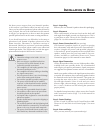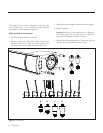
12 Placement
good pinpoint focusing. Your ideal listening position
and speaker position will be determined by:
•Tightnessandextensionofbassresponse
•Widthofthestage
•Pinpointfocusingofimaging
Once you have determined the best of all three of these
considerations, you will have your best speaker location.
The Extra “Tweak”
This extra “tweak” may be useful when your speakers
are placed in a dedicated listening room. Use the fol-
lowing procedure and measurements for your speakers
placement to see what can happen to your system’s per-
formance. These formulas will help determine optimum
placement of your speakers to minimize standing waves.
1 Distance from the front wall (in front of the listening
position) to the center of the curvilinear transducer: To
determine distance from the front wall, measure the
ceiling height (inches) and multiply the figure by 0.618
(i.e. ceiling height (inches) x 0.618 = the distance from
the front wall to the center of the curvilinear transducer).
2 Distance from the side-walls to the center of the cur-
vilinear transducer: To determine distance from the
side walls, measure the width of your room in inches
and divide by 18. Next, multiply the quotient by 5 (i.e.
room width in inches / 18 x 5 = the distance from the
side-walls to the center of the curvilinear transducer).
Enjoy Yourself
The Summit X is a very refined speaker and benefits from
care in setup. With these tips in mind you will find, over
your months of listening, that small changes can result in
measurable differences. As you live with your speakers,
do not be afraid to experiment with their positioning until
you find the optimal relationship between your room and
speaker system that gives to you the best results. Your
efforts will be rewarded.
Your Room
This is one of those areas that requires both a little back-
ground to understand and some time and experimentation
to obtain the best performance from your system.
Your room is actually a component and an important part
of your system. This component is a very large variable
and can dramatically add to, or subtract from, a great
musical experience.
All sound is composed of waves. Each note has its own
wave size, with the lower bass notes literally encompass-
ing from 10’ feet to over 40’ feet. Your room participates
in this wave experience like a three dimensional pool with
waves reflecting and becoming enhanced depending on
the size of the room and the types of surfaces in the room.
Remember, your audio system can literally generate all of
the information required to recreate a musical event in
time, space, and tonal balance. Ideally, your room should
not contribute to that information. However, every room
does contribute to the sound to some degree. Fortunately
MartinLogan has designed the Summit X to minimize
these anomalies
Let’s talk about a few important terms before we begin.
Terminology
Standing Waves
The parallel walls in your room will reinforce certain notes
to the point that they will sound louder than the rest of
the audio spectrum and cause “one note bass”, “boomy
bass” or “bloated bass”. For instance, 100Hz represents a
10 feet wavelength. Your room will reinforce that specific
frequency if one of the dominant dimensions is 10 feet.
Large objects in the room such as cabinetry or furniture
can help to minimize this potential problem. Some seri-
ous “audiophiles” will literally build a special room with
no parallel walls just to help eliminate this phenomenon.
Reflective Surfaces (near-field reflections)
The hard surfaces of your room, particularly if close to your
speaker system, will reflect some waves back into the room
over and over again, confusing the clarity and imaging of
your system. The smaller sound waves are mostly affected
here, and occur in the mid and high frequencies. This is
where voice and frequencies as high as the cymbals occur.
Resonant Surfaces and Objects
All of the surfaces and objects in your room are subject to


















